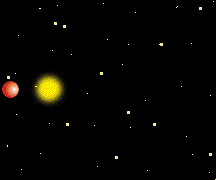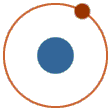|
 What
Is an Orbit? What
Is an Orbit?
Here
we see a planet in an orbit around a star.
The planet follows the same path over
and over in a cycle. The time to complete
one orbit is called the "period."
The period of the Earth's orbit is defined
as one year. Unless some other massive
object comes nearby and disturbs the planet,
it will continue in the same orbit forever.
This orbit is "stretched
out" or elongated. (The technical term is "eccentric.")
Thus, during part of the orbit, the planet is very close to the
star, and during another part, the planet is very far from the star.
The point of the orbit where the planet is closest to the star is
called the "perihelion." The point where the planet is
farthest from the star is called the "aphelion."
Several things are happening
to the planet in the animation during its orbit. As the planet comes
closer to the star, its surface gets warmer (indicated by the change
in color), just like you get warmer when you move closer to a fire.
For an orbit like that shown, the temperature changes on the surface
of the planet would be huge! Also, notice that as the planet gets
closer to the star, it moves faster because the pull of star's gravity
on the planet becomes stronger.
 Fortunately
for us, in our Solar System the orbit
shown above is typical of a comet or an
asteroid, but not planets. Instead, the
orbits of the planets, including the Earth,
are nearly circular like the orbit shown
to the right. For this reason, the distance
of the planet is almost constant, so the
speed of the planet is nearly constant,
and, most important for us, the surface
temperature remains nearly constant. (Note:
The seasons on Earth are not caused
by changes in the distance between the
Sun and the Earth, but are due to the
tilt of the Earth. Fortunately
for us, in our Solar System the orbit
shown above is typical of a comet or an
asteroid, but not planets. Instead, the
orbits of the planets, including the Earth,
are nearly circular like the orbit shown
to the right. For this reason, the distance
of the planet is almost constant, so the
speed of the planet is nearly constant,
and, most important for us, the surface
temperature remains nearly constant. (Note:
The seasons on Earth are not caused
by changes in the distance between the
Sun and the Earth, but are due to the
tilt of the Earth.
Back
| Next
|











